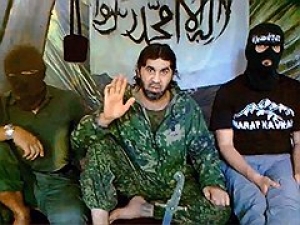
Kizilyurt Remains a Hotbed of the Dagestani Insurgency
Publication: Eurasia Daily Monitor Volume: 9 Issue: 143
By:

Having been tipped off about the whereabouts of several members of the armed resistance in Dagestan, the republican security services identified their location on July 21. Special units of the FSB (Federal Security Service) and the Interior Ministry blocked the suspected rebels in a four-story, two-entrance apartment block on Sulakskaya Street in the town of Semender, a Makhachkala suburb. The house’s owner and his spouse were allowed to leave their home after negotiations with the security services. According to sources in the security services, the rebels responded to an offer to surrender by firing chaotically and were quickly killed by return fire. One of the rebels was preliminarily identified as 37-year-old Temirbek Temirbekov, better known as Emir Abu Muaz, the leader of the Kizilyurt jamaat. A law enforcement spokesperson said the slain rebel leader was involved in attacks on law enforcement forces and extorting local businessmen under the threat of physical violence. The second rebel killed in the incident was identified as 39-year-old Rustam Yakhyaev (https://xn--c1adwdmv.xn--p1ai/news/kavkaz/1554670.html).
Emir Abu Muaz was considered one of the most prominent commanders of the armed opposition of Dagestan. He joined the insurgency in 2007, when he was released from detention after serving 10 years of a 12-year sentence on charges of armed robbery. Temirbek Temirbekov quickly advanced to prominence among the most famous commanders of the Kizilyurt district after he joined the resistance (www.kommersant.ru/doc/1986222/print). Temirbekov assumed the position of the head of the Kizilyurt jamaat after the death of the previous leader of the jamaat, Magomed Dalgatov, who was killed on February 1, 2011. Subsequently, Temirbekov acquired notoriety in Dagestan for widely circulating personal warnings to various target audiences, such as the businessmen and police officers. In one such address, published on the Internet on July 17 – i.e., four days before his death – he reproached the residents of the Kizilyurt district village of Kirovaul for indifference to the Islamic community’s life. Temirbekov stated that even though the village boasted nearly the highest number of theologians and Muslim clerics in Dagestan, none of them had dared to talk about jihad in their sermons. The rebel also reproached the youth who, according to him, toiled excessively with online social networking, such as Facebook, Odnoklassniki, and Vkontakte (https://ummanews.ru/news/last-news/7850-2012-07-17-17-03-03.html).
A pseudo people’s front dubbed “Robin Hoods” was “organized” specifically to counter Temirbekov, as the supposedly volunteer group publicly challenged Emir Abu Muaz (www.kommersant.ru/doc/1976749). In a video recording, the Robin Hoods of Kizilyurt demanded that Abu Muaz ask the residents of the district to pardon him for his acts and stop his activities (www.youtube.com/watch?v=yu8F–J-mpA).
Kizilyurt district is situated in the northern part of the republic and borders such unstable districts of Dagestan as Khasavyurt and Buinaksk. Kizilyurt district has an ethnic majority population of Avars, who constitute one of the largest and one of the most martial ethnic groups in Dagestan. The district, along with the neighboring areas, has experienced a surge in insurgent activities over the past several months forcing Moscow to station a unit of Russian Interior Ministry troops in the district.
After the death of Emir Abu Muaz, the Kizilyurt group (aka jamaat of the city of Kizilyurt) did not cease its operations. According to sources in the Dagestani Interior Ministry, on July 24 the Interior Ministry and FSB forces located several members of the armed opposition in the village of Novy Kostek in Khasavyurt district. The Russian National Antiterrorist Committee reported that three suspected rebels were killed in an ensuing shootout. Two of the slain suspects were preliminarily identified as brothers: 46-year-old Kurban Aliev and 38-year-old Shakhban Aliev of Novy Kostek village. The identity of the third suspect was not established (www.rg.ru/2012/07/24/reg-skfo/opoznani-anons.html). The slain suspected rebels were described as members of the Kizilyurt jamaat (https://dagestan.kavkaz-uzel.ru/articles/210186/). A Dagestani law enforcement agent was wounded during the shootout.
Also in Kizilyurt district, Interior Ministry and FSB personnel launched an operation against arms traders on July 24 (www.riadagestan.ru/news/2012/7/25/139957). In the neighboring city of Khasavyurt on the night of July 24, unidentified assailants fired shots at an FSB serviceman when he got out of his car and was walking toward his home. The serviceman was seriously wounded in the torso and head (www.riadagestan.ru/news/2012/7/25/139937/).
On July 25, the authorities announced the arrest of a 27-year-old resident of the village of Gukhrag in Dagestan’s Tabasaran district. The suspect was accused of supporting members of illegal armed groups (https://news.rufox.ru/texts/2012/07/25/243318.htm). A resident of the village of Chernyaevka in Kizlyar district, Shakhban Gasanov, who was detained on July 17 for illegal possession of arms, was also accused of supporting the rebels. However, Gasanov’s mother said the police did not find arms in their household initially, but found them after a follow up search of their shed four days later. The suspect’s mother alleged that the police planted the weapons (https://kabardino-balkaria.kavkaz-uzel.ru/articles/210193/).
One should bear in mind that the Kizilyurt jamaat has a long history of operations that dates back to the Soviet period, when it was headed by Sheikh Bagautdin Kebedov (Kizilyurtovksy), who became the spiritual leader of the militants in the 1990s, including the period of the start of the second Chechen war (1999-2001) (www.kavkaz-uzel.ru/articles/203107/). Another well-known Islamic figure in Dagestan, Abbas Kebedov, also comes from this district. Salafis from across the North Caucasus used to gather in Kizilyurt to hear the sermons of Bagautdin Kebedov, their spiritual leader. It also is worth mentioning that it was Sheikh Bagautdin Kebedov who organized the Islamist incursion and uprising in the Dagestani mountains around the village of Botlikh in July-August 1999 and attempted to proclaim the Islamic Republic of Dagestan (https://magazines.russ.ru/oz/2003/5/2003_5_62.html). However, since Kebedov and his followers were not well received in Dagestan, they retreated back into Chechnya and asked Shamil Basaev for assistance. This jamaat, therefore, is one of the oldest in Dagestan, so it is not surprising that, along with the Buinaksk, Khasavyurt and Karabudakhkent districts, Kizilyurt district has been considered one of the most insecure areas in Dagestan.
Thus, the latest events indicate that even the deployment of a potent Interior Ministry force from Chechnya has not greatly altered the situation in Dagestan. Dagestan’s insurgency remains at the forefront of the North Caucasian armed resistance.
The Dagestani jamaats have consistently proved their vitality despite the enormous casualties they have suffered across the republic as a result of Russian security services operations. The jamaats have achieved a high degree of interchangeability, replacing people killed in action with new militants. Consequently, neither the Dagestani nor the Russian authorities should pay too much attention to the death of jamaat leaders because the Kizilyar jamaat has such a long history of replenishing its fighter and instead should focus on the conditions that attract the insurgents. Recently it was announced that Italy plans to invest up to $1 billion into the North Caucasus resorts (www.rusbg.com/realty/italyantsi-sobralis-stroit-gostinitsi-na-severnom-kavkaze.html). Against the background of daily news about the insurgency in Dagestan, it is ironic that we are still receiving news about Kremlin plans to solve regional problems by building local ski slopes.




